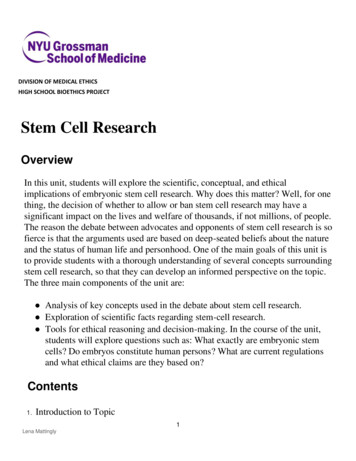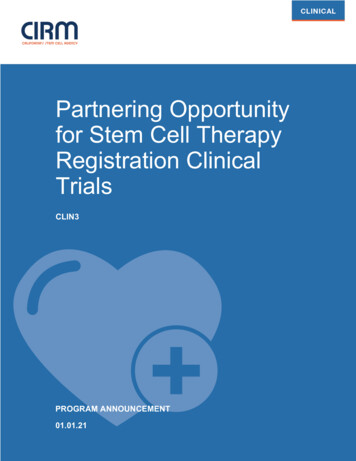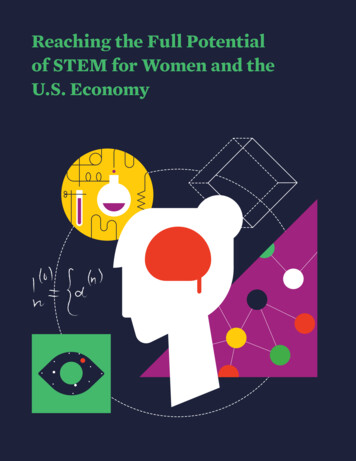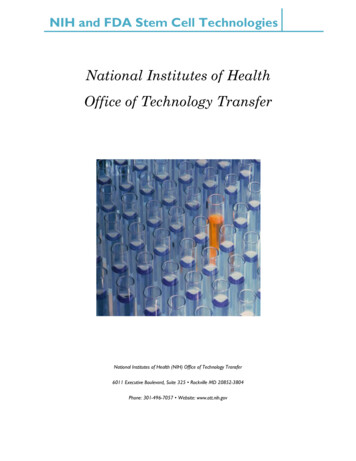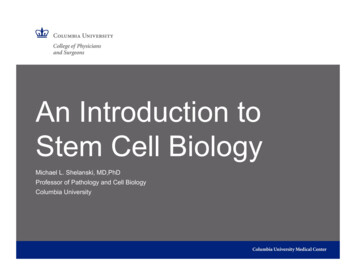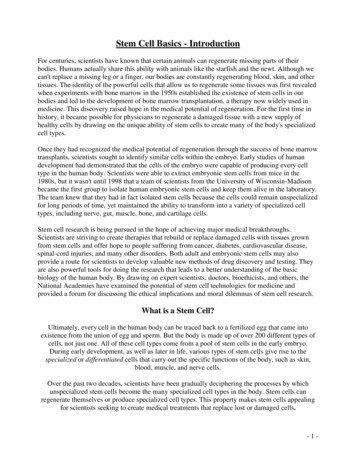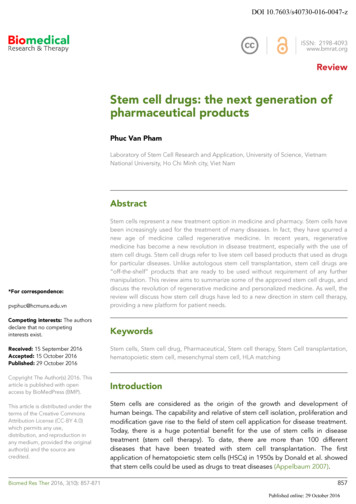
Transcription
DOI 10.7603/s40730-016-0047-zISSN: 2198-4093www.bmrat.orgReviewStem cell drugs: the next generation ofpharmaceutical productsPhuc Van PhamLaboratory of Stem Cell Research and Application, University of Science, VietnamNational University, Ho Chi Minh city, Viet NamAbstractpvphuc@hcmuns.edu.vnStem cells represent a new treatment option in medicine and pharmacy. Stem cells havebeen increasingly used for the treatment of many diseases. In fact, they have spurred anew age of medicine called regenerative medicine. In recent years, regenerativemedicine has become a new revolution in disease treatment, especially with the use ofstem cell drugs. Stem cell drugs refer to live stem cell based products that used as drugsfor particular diseases. Unlike autologous stem cell transplantation, stem cell drugs are“off-the-shelf” products that are ready to be used without requirement of any furthermanipulation. This review aims to summarize some of the approved stem cell drugs, anddiscuss the revolution of regenerative medicine and personalized medicine. As well, thereview will discuss how stem cell drugs have led to a new direction in stem cell therapy,providing a new platform for patient needs.Competing interests: The authorsdeclare that no competinginterests exist.Keywords*For correspondence:Received: 15 September 2016Accepted: 15 October 2016Published: 29 October 2016Copyright The Author(s) 2016. Thisarticle is published with openaccess by BioMedPress (BMP).This article is distributed under theterms of the Creative CommonsAttribution License (CC-BY 4.0)which permits any use,distribution, and reproduction inany medium, provided the originalauthor(s) and the source arecredited.Biomed Res Ther 2016, 3(10): 857-871Stem cells, Stem cell drug, Pharmaceutical, Stem cell therapy, Stem Cell transplantation,hematopoietic stem cell, mesenchymal stem cell, HLA matchingIntroductionStem cells are considered as the origin of the growth and development ofhuman beings. The capability and relative of stem cell isolation, proliferation andmodification gave rise to the field of stem cell application for disease treatment.Today, there is a huge potential benefit for the use of stem cells in diseasetreatment (stem cell therapy). To date, there are more than 100 differentdiseases that have been treated with stem cell transplantation. The firstapplication of hematopoietic stem cells (HSCs) in 1950s by Donald et al. showedthat stem cells could be used as drugs to treat diseases (Appelbaum 2007).!857
ISSN: 2198-4093www.bmrat.orgClinical applications of HSCs rapidly increased with more and more diseasestreated with HSCs. From 1970s to 2000s, all HSC transplantations (HSCTs) wereindicated for hematologic malignancies. In recent years, HSCTs have also beenused in solid tumor treatment (Kotloff et al., 2004; Rodenhuis et al., 2003;Tallman et al., 2003).Human leukocyte antigen (HLA) matching is an important component forsuccessful HSCT (Lee et al., 2007; Petersdorf et al., 1998; Sasazuki et al., 1998).Therefore, in the initial years of HSCT, almost all cases were performed asautologous transplantation of HSCs. The stem cells were collected from bonemarrow, umbilical cord blood or peripheral blood. However, autologous HSCThad some limitations, especially with regard to the quality and quantity of HSCs.More importantly, autologous HSCs have some mutations in their genome whichlimit their use in treating genetic diseases. To overcome these limitations,allogenic HSCT was suggested as a better platform; the use of selected HSCsamples with greater quality and quantity can be controlled. In light of thedemand for allogeneic HSCT, stem cell banks have been developed in severalcountries, such US, Japan, Korea, England and Germany (Armson et al., 2015).With greater characterization of HSCs (including HLA typing), stem cells wereable to be commercialized as pharmaceutical products for transplantation in theUS, beginning in the 2000s. Ducord and HemaCord are two HSC drugsintroduced around 2010 in the US. However, since the HLA matching ratio is verylow in the human population (about 1/100,000), the business of HSC drugs hasonly slowly developed.From 2012 till now, stem cell drugs have advanced with mesenchymal stem cell(MSC) based products. Similar to HSCs, in the first clinical applications of MSCs,the MSCs were administered as autologous transplantation. Indeed, HLAmatching as well as immune rejection are taken into consideration beforetransplantation. Some allogenic transplantations of MSCs have usedimmunosuppressive drugs to prevent or reduce the immune rejection of graftedcells in the host. However, increasing studies have confirmed that MSCs exhibitstrong immune modulation capacity that can regulate the host’s immune system;as well, they exhibit low immunogenicity compared to HSCs and other cells(Ankrum et al., 2014; Hoogduijn et al., 2010; P De Miguel et al., 2012;Rasmusson, 2006).MSCs have been transplanted into patients without immune suppression andwithout HLA matching with safety (Hare et al., 2009; Karussis et al., 2010; Lalu etal., 2012; Wang et al., 2012). Based on such results, MSC based products havenow been developed as drugs for patients with clear indications. The first MSCbased stem cell drug was officially approved by the Food and Drug Agency ofCanada in 2012. This drug was indicated to treat graft versus host disease(GVHD) related to HSCT.Biomed Res Ther 2016, 3(10): 857-871!858
ISSN: 2198-4093www.bmrat.orgThis review aims to summarize and discuss the development and growth of stemcell drugs in medicine and pharmacy. Stem cell drug has now become a newand potentially important member of regenerative medicine (Fig. 1).Figure 1. Stem cell drugs in regenerative medicine. Stem cell drugs are newmembers of stem cell therapy, personalized medicine and regenerativemedicine. The development of stem cell drugs have impacted and advanced thestem cell industry as well as the pharmaceutical industry.What are stem cell drugs?A drug is defined as any substance other than food that when inhaled, injected,smoked, consumed, absorbed via a patch on the skin or dissolved under thetongue causes a physiological change in the body. In pharmacology, a drug (orpharmaceutical drug) is a substance used to treat, cure, prevent or diagnose adisease or to promote well-being. According to this definition, a drug mustsatisfy some criteria, such as having indication to treat any disease and is an offthe-shelf product. Therefore, by definition stem cell drugs are off-the-shelfproducts based on stem cells that are indicated to treat, cure, prevent ordiagnose a disease or to promote well-being.As off-the-shelf products, stem cell drugs are used in the allogeneic setting instem cell transplantation. There are key differences between allogenic stem celltransplantation and stem cell drugs. The biggest difference between them is thatthe stem cell drug is a product, while allogenic stem cell transplantation is aprocedure using the stem cell drug. Moreover, the former is approved as a drugand the latter is approved as a medical device. The details of the maindifferences are listed in Table 1.Biomed Res Ther 2016, 3(10): 857-871!859
ISSN: 2198-4093www.bmrat.orgTable 1. Main differences between stem cell drugs and allogenic stem celltransplantationStem cell drugsAllogenic stem cell therapyProducts of stem cellsProcedures using stem cellsOff-the-shelf productsUsing off-the-shelf products or directly usefrom donorsProduced with large quantity withconsistent qualityQuality of products are controlledfrom batch to batch according toGMP guidelinesApproved as drugsQuality differs from batch tobatchQuality differs from batch tobatch depending on donors andproduction proceduresApproved as medical devicesStem cell drugs: from personalized to universalizedPersonalized medicine is a medical procedure that separates patients intodifferent groups—with medical decisions, practices, interventions and/orproducts being tailored to the individual patient based on their predictedresponse or risk of disease. Stem cells offers a new approach in personalizedmedicine. Indeed, the definition of “personalized medicine” using stem cells hasbecome a popular term in the last 10 years. To date, there are at least 2approaches using stem cells in personalized medicine, as presented in Fig. 2.In this review, we mainly discuss the application of stem cells in stem celltherapeutic transplantation. In stem cell transplantation, autologous stem cellsfrom a patient are used to treat his or her disease. However, the reduction inquality and quantity of stem cells due to aging is a major limitation of thisapproach. However, after Yamanaka’s success with induced pluripotent stem cellproduction from skin fibroblasts (Takahashi and Yamanaka, 2006), scientistshoped that personalized medicine would lead to greater clinical applicationsusing autologous reprogrammed stem cells (Fig. 3). To date, this approach hasfaced many limitations and proven to be quite difficult. Even if all the technicaldifficulties and limitations related to this approach could be solved in the nearfuture, the high price of this procedure would remain a challenge. Indeed, theprocess of fibroblast isolation, culture and reprogramming for clinicalapplications is very complex, time-consuming and expensive.Stem cell drug for universalized medicine has become a new option in stem celltherapy. Stem cell drugs can overcome all the major limitations of autologousstem cells. Particularly, the quality, quantity and price can be controlled. Whilepersonalized medicine requires more time for development and is, in someBiomed Res Ther 2016, 3(10): 857-871!860
ISSN: 2198-4093www.bmrat.orgways, a form of medicine for the “future”, universalized medicine is more “real”in that the “off-the-shelf”, allogeneic stem cell drugs can be used for manypatients.Figure 2. Applications of stem cells in personalized medicine. Stem cells canbe used in personalized medicine in various settings, including disease modelingfor drug screening or evaluation, stem cell gene therapy for gene correction,and stem cell therapeutic transplantation.Figure 3. Induced pluripotent stem cells for personalized medicine.Fibroblasts initially isolated from skin are then reprogrammed into inducedpluripotent stem cells (iPSCs). The iPSCs are further differentiated into specificcell types before transplantation into patients.Biomed Res Ther 2016, 3(10): 857-871!861
ISSN: 2198-4093www.bmrat.orgStem cell drugs: Drug mechanisms and propertiesStem cell drugs are mainly produced from HSCs and MSCs (Table 3). However,another kind of stem cell (limbal stem cells) can also be used to produce someproducts for corneal regeneration. The mechanisms of action of these stem celldrugs are different. While HSC based drugs can regenerate the hematopoieticsystem in treated patients (via homing and differentiation to functional cells),MSC based drugs typically target the immune system and facilitate healing atinjured sites by paracrine or endocrine factors.Hematopoietic stem cell based drugsHSCs are stem cells that can produce blood cells, including white blood cells,red blood cells and platelets, through the process of hematopoiesis. In adults,HSCs are located in the bone marrow and maintain the blood system in thebody. The definition of HSC has evolved since the time HSCs were firstdiscovered in 1961 (Till and Mc, 1961). The hematopoietic tissue contains cellswith long-term and short-term regeneration capacities as well as committedmultipotent, oligopotent and unipotent progenitors. Nowadays, HSCs are foundin and mostly isolated from bone marrow, peripheral blood and umbilical cordblood. The first successful bone marrow derived HSC transplantation wasperformed in 1950s by E. Donnall Thomas at Fred Hutchinson Cancer ResearchCenter (Washington, USA); his work was later recognized with a Nobel Prize inPhysiology or Medicine. Thomas infused bone marrow cells to repopulate thebone marrow and produce new blood cells. Furthermore, the first physician toperform a successful human bone marrow transplant for a disease other thancancer was Robert A. Good at the University of Minnesota in 1968. To date,HSCTs have been evaluated in a variety of malignant and non-malignantdiseases (Table 2).The roles of HSCs in both malignant and non-malignant diseases weredetermined by homing and differentiation of HSCs at bone marrow to form anew hematogenesis system. However, HSCs exert strong immunogenicity on thehost immune system. Therefore, HLA matching is critical prior to HSCT. Therequirement of HLA matching, however, restricts the development andadvancement of HSC based stem cell drugs since there is extremely low HLAmatching in the human population. Moreover, it is difficult to induce stem cellproliferation in vitro to increase cell quantity. Although umbilical cord bloodseems like a good candidate for an unlimited source of HSCs, it too haschallenges which limit its application, including the high cost and time forumbilical cord blood cell collection, enrichment and characterization (e.g. HLAtyping).Biomed Res Ther 2016, 3(10): 857-871!862
ISSN: 2198-4093www.bmrat.orgTable 2. Indications of HSC transplantationMalignantNon-malignantAcute myeloid leukemia (AML)ThalassemiaChronic myeloid leukemia (CML)Sickle cell anemiaAcute lymphoblastic leukemia (ALL)Aplastic anemiaHodgkin’s lymphomaFanconi anemiaNon-Hodgkin’s lymphomaImmune deficiency syndromesNeuroblastomaInborn errors of metabolismEwing’s sarcomaAutoimmune diseasesMultiple myelomaMyelodysplastic syndromesGliomas, other solid tumorsMesenchymal stem cell based drugsMesenchymal stem cells (MSCs) are the most popular stem cells in the humanbody. They are present in almost all tissues but the most common sources arebone marrow, adipose tissue, umbilical cord tissue, umbilical cord blood, andplacenta. Although the MSCs from the various tissues share common properties,they also exhibit different properties, as suggested by Dominici et al. (2006)(Dominici et al., 2006). Unlike other kinds of stem cells, MSCs aremultifunctional; they not only differentiate into multiple cell lineages but theyalso produce a pool of cytokines and growth factor to execute immunemodulation and promote injury healing and tissue regeneration (Caplan andDennis, 2006; Chen et al., 2008; Hocking and Gibran, 2010; Majumdar et al.,2000; Ren et al., 2008).MSCs are favorable for clinical applications of stem cell therapy due to theirmultiple lineage differentiation potential. Stem cells can be differentiated in vitroor in vivo into functional cells which can replace aged or damaged cells. Indeed,some applications of stem cell therapy have entailed differentiating cells fromstem cells in vitro and then transplanting them into the recipient as cellulartherapy or in combination with biomaterials as tissue engineering therapy. Instem cell transplantation, scientists are also evaluating and trying to promote invivo differentiation in the microenvironment. Ideally, stem cells can home toinjured tissue sites in the body and persist for a long time. Persistence of stemBiomed Res Ther 2016, 3(10): 857-871!863
ISSN: 2198-4093www.bmrat.orgcells has been observed in HSC transplantation and, in some cases, inautologous MSC transplantation. Indeed, in MSC transplantation more than 50%of grafted cells typically die in the recipient from rejection by the immune systemand selection in the microenvironment. Autologous transplantation or HLAmatching, therefore, are necessary to overcome the kinds of challenges.Autologous stem cells, however, cannot be produced to mass (industrial) scaleand thus stem cell based drugs are highly advantageous. As aforementioned,one important component of stem cell based drugs is the capacity for industrialscale production with similar quality from batch to batch. In most cases, MSCswere used as the source for stem cell based drugs. The two main mechanisms oftherapy mediated by stem cell drugs are immune modulation and paracrine/endocrine effects. Immune modulation is the most common mechanism ofcommercialized stem cell drugs generated nowadays; about 80% of stem celldrug products act via immune modulation. This means that the host immunesystem can be regulated by either indirect or direct interactions between stemcells and host immune cells.Immune modulation has been observed and documented for mesenchymalstem cells from bone marrow (Bai et al., 2009), adipose tissue (Mello et al.,2015), umbilical cord (Barcia et al., 2015; Cutler et al., 2010), and Wharton’s jelly(Prasanna et al., 2010; Weiss et al., 2008). Unlike immune suppression (wherebyall immune cells are inhibited in their function), immune modulation is a dynamicprocess whereby only some cells are affected, i.e. only some cells stimulated. Byimmune modulation, MSCs can effectively suppress both acute and chronicinflammation. Some stem cell drugs based on MSCs have been approved foruse in certain countries and have shown their capability to exert immunemodulation; one example is the first stem cell drug (Prochymal) that wasevaluated for treatment of GVHD and approved by the Canadian Food and DrugAgency.The second main mechanism of stem cell drugs relates to the growth factorsproduced by stem cells. MSCs can produce a pool of growth factors andcytokines which exert biological effects on other cells. MSCs can produce factorsthat stimulate host stem cells, inhibit apoptosis, and stimulate angiogenesis(Caplan and Dennis, 2006; Chen et al., 2008; Hocking and Gibran, 2010;Majumdar et al., 2000; Ren et al., 2008). Some cytokines exert paracrine effectswhile others may have endocrine effects.The future of stem cell drugsIn recent years, stem cell therapeutics studies has progressed from use of wholestem cells to components derived from stem cells. These components haveincluded stem cell extracts, microvesicles and exosomes, all of which exhibitvarious biological activities. For example, exosomes from MSCs have functionsBiomed Res Ther 2016, 3(10): 857-871!864
ISSN: 2198-4093www.bmrat.orgsimilar to whole MSCs, including repair of tissue damage, suppression ofinflammatory responses, and modulation of the immune system. Hu et al. (2016)demonstrated that exosomes from human adipose derived stem cells canaccelerate cutaneous wound healing via optimizing the characteristics offibroblasts (Hu et al., 2016). Similar to MSCs, extra-cellular vesicles (EVs) fromMSCs can modulate the immune system (Burrello et al., 2016).Table 3. Updated stem cell products approved for clinical useTrade nameBiomed Res Ther 2016, 3(10): 857-871StemcellCompanyApproved onChildren'sMedicalCenter2013 US, FDAFor use in unrelated donorhematopoietic progenitor celltransplantation procedures inconjunction with an appropriatepreparative regimen forhematopoietic and immunologicreconstitution in patients withdisorders affecting the hematopoieticsystem that are inherited, acquired, orresult from myeloablative treatment.HemacordHPC,CordBloodNew YorkBloodCenter, Inc.2013US, FDAFor use in unrelated donorhematopoietic progenitor celltransplantation procedures inconjunction with an appropriatepreparative regimen for hematopoieticand immunologic reconstitution inpatients with disorders affecting thehematopoietic system that areinherited, acquired, or result frommyeloablative treatment.DucordHPC,CordBloodDukeUniversitySchool ofMedicine2012US, FDAFor use in unrelated donorhematopoietic progenitor celltransplantation procedures inconjunction with an appropriatepreparative regimen for hematopoieticand immunologic reconstitution inpatients with disorders affecting thehematopoietic system that areinherited, acquired, or result frommyeloablative ty ofColoradoCord BloodBank2012US, FDAFor use in unrelated donorhematopoietic progenitor celltransplantation procedures inconjunction with an appropriatepreparative regimen for hematopoieticand immunologic reconstitution inpatients with disorders affecting thehematopoietic system that areinherited, acquired, or result frommyeloablative treatment.!865
ISSN: mmunityBloodCenters, Inc.2013US, FDAFor use in unrelated donorhematopoietic progenitor celltransplantation procedures inconjunction with an appropriatepreparative regimen for hematopoieticand immunologic reconstitution inpatients with disorders affecting thehematopoietic system that areinherited, acquired, or result frommyeloablative treatment.NoneHPC,CordBloodBloodworks2016US, FDAFor use in unrelated donorhematopoietic progenitor celltransplantation procedures inconjunction with an appropriatepreparative regimen for hematopoieticand immunologic reconstitution inpatients with disorders affecting thehematopoietic system that areinherited, acquired, or result frommyeloablative aTreatment of graft versus host disease(GVHD)CartistemMSCsMEDIPOSTCo., Ltd.2012Korean FDATreatment of knee cartilage defectscaused by degenerative osteoarthritisor repeated traumaTemcell HSInj.MSCsJCRPharmaceuticals Co. Ltd.(Licensee ofMesoblastLimited)2015Japan FDATreatment of acute graft versus hostdisease (aGVHD) in children and adultsStempeucelMSCsStempeuticsResearchPVT Ltd.2016Indian FDACLI patients due to Buerger's diseaseExosomes from stem cells can also affect other systems and organs, such as thecardiovascular system, kidney, liver, nervous system and musculoskeletal system.In the cardiovascular system, exosomes have been suggested ascardioprotective agents (Lai et al., 2010); they have been shown to haveproangiogenic effects (Bian et al., 2014) and involvement in reduction ofapoptosis and cardiac fibrosis (Feng et al., 2014). Arslan et al. (2013) showedthat a single intravenous administration of exosomes was effective in enhancingcardiac function and geometry after myocardial infarction due to bioenergeticsre-establishment (increased ATP production), oxidative stress reduction and prosurvival signaling activation (enhanced PI3K/Akt signaling) (Arslan et al., 2013).Recently, Zhang et al. (2016) showed that MSC derived exosomes promotedcardiac stem cell proliferation in vitro (Zhang et al., 2016). In kidney, studies haveBiomed Res Ther 2016, 3(10): 857-871!866
ISSN: 2198-4093www.bmrat.orgshown that acute kidney injury can be effectively treated with MSC basedexosomes (Jiang et al., 2016; Zhou et al., 2013). Moreover, MSC derivedexosomes can also be used to treat fibrotic liver disease (Hyun et al., 2015; Li etal., 2013). In some diseases of the musculoskeletal system, exosomes can triggerdifferentiation of MSCs into osteoblasts (Narayanan et al., 2016) and stimulateskeletal muscle regeneration by enhancing myogenesis and angiogenesis(Nakamura et al., 2015). In the nervous system, MSC derived exosomes havebeen evaluated in the treatment of neurological and neurodegenerativediseases; they have been shown to enhance angiogenesis and neurogenesis,reduce inflammation and improve spatial learning and sensorimotor function(Kim et al., 2016; Zhang et al., 2015).Taken together, the aforementioned discoveries suggest the dawn of a new eraof stem cell therapy, i.e. stem cell drugs. Here, components (mRNA, protein andpeptides) from stem cells, in microvesicles or exosomes, can be effective overwhole stem cells. Certainly, the advantages of stem cell drugs include reductionof immunogenicity and easy processing, storage and delivery. Stem cells freedrugs may play a potentially important and emerging role in regenerativemedicine.ConclusionStem cell drugs are new members of pharmaceutical medicines that areproduced from stem cells. From 2012 to now, more than ten stem cell drugshave been approved in various countries for clinical applications. These productsmay contain live hematopoietic stem cells or mesenchymal stem cells. With theiradvantages such as decreased immunogenicity and ease of processing, stemcell drugs have emerged as a promising new platform in the field stem celltherapy around the world. As a new product of pharmaceutical medicine, it isanticipated that stem cell drugs will significantly contribute to both thepharmaceutical and medical industries in the near future. In clinical applications,besides the stem cell drugs which contain live and whole stem cells, new stemcell drugs containing components from stem cells (such as extracts, exosomesand vesicles) are in development and expected to be launched soon.Lists of abbreviationsEVs: xtra-cellular vesicles; FDA: Food and Drug Angency; GVHD: graft versus hostdisease; HLA: Human leukocyte antigen; HPC: Hematopoietic progenitor cells; HSC:Hematopoietic stem cells; HSCT: HSC transplantations.Biomed Res Ther 2016, 3(10): 857-871!867
ReferencesISSN: 2198-4093www.bmrat.org1. Ankrum, J.A., Ong, J.F., and Karp, J.M. (2014). Mesenchymal stem cells: immuneevasive, not immune privileged. Nature biotechnology 32, 252-260.2. Appelbaum , F.R. (2007). Hematopoietic-Cell Transplantation at 50. New EnglandJournal of Medicine 357, 1472-1475.3. Armson, B.A., Allan, D.S., and Casper, R.F. (2015). Umbilical Cord Blood:Counselling, Collection, and Banking. J Obstet Gynaecol Can 37, 832-846.4. Arslan, F., Lai, R.C., Smeets, M.B., Akeroyd, L., Choo, A., Aguor, E.N., Timmers, L.,van Rijen, H.V., Doevendans, P.A., Pasterkamp, G., et al. (2013). Mesenchymal stemcell-derived exosomes increase ATP levels, decrease oxidative stress and activatePI3K/Akt pathway to enhance myocardial viability and prevent adverse remodelingafter myocardial ischemia/reperfusion injury. Stem Cell Res 10, 301-312.5. Bai, L., Lennon, D.P., Eaton, V., Maier, K., Caplan, A.I., Miller, S.D., and Miller, R.H.(2009). Human bone marrow-derived mesenchymal stem cells induce Th2-polarizedimmune response and promote endogenous repair in animal models of multiplesclerosis. Glia 57, 1192-1203.6. Barcia, R.N., Santos, J.M., Filipe, M., Teixeira, M., Martins, J.P., Almeida, J., AguaDoce, A., Almeida, S.C., Varela, A., Pohl, S., et al. (2015). What Makes UmbilicalCord Tissue-Derived Mesenchymal Stromal Cells Superior Immunomodulators WhenCompared to Bone Marrow Derived Mesenchymal Stromal Cells? Stem Cells Int2015, 583984.7. Bian, S., Zhang, L., Duan, L., Wang, X., Min, Y., and Yu, H. (2014). Extracellularvesicles derived from human bone marrow mesenchymal stem cells promoteangiogenesis in a rat myocardial infarction model. J Mol Med (Berl) 92, 387-397.8. Burrello, J., Monticone, S., Gai, C., Gomez, Y., Kholia, S., and Camussi, G. (2016).Stem Cell-Derived Extracellular Vesicles and Immune-Modulation. Front Cell DevBiol 4, 83.9. Caplan, A.I., and Dennis, J.E. (2006). Mesenchymal stem cells as trophic mediators.Journal of cellular biochemistry 98, 1076-1084.10. Chen, L., Tredget, E.E., Wu, P.Y., and Wu, Y. (2008). Paracrine factors of mesenchymalstem cells recruit macrophages and endothelial lineage cells and enhance woundhealing. PloS one 3, e1886.11. Cutler, A.J., Limbani, V., Girdlestone, J., and Navarrete, C.V. (2010). Umbilical cordderived mesenchymal stromal cells modulate monocyte function to suppress T cellproliferation. J Immunol 185, 6617-6623.12. Dominici, M., Le Blanc, K., Mueller, I., Slaper-Cortenbach, I., Marini, F., Krause, D.,Deans, R., Keating, A., Prockop, D., and Horwitz, E. (2006). Minimal criteria fordefining multipotent mesenchymal stromal cells. The International Society forCellular Therapy position statement. Cytotherapy 8, 315-317.13. Feng, Y., Huang, W., Wani, M., Yu, X., and Ashraf, M. (2014). Ischemicpreconditioning potentiates the protective effect of stem cells through secretion ofexosomes by targeting Mecp2 via miR-22. PLoS One 9, e88685.Biomed Res Ther 2016, 3(10): 857-871!868
ISSN: 2198-4093www.bmrat.org14. Hare, J.M., Traverse, J.H., Henry, T.D., Dib, N., Strumpf, R.K., Schulman, S.P.,Gerstenblith, G., DeMaria, A.N., Denktas, A.E., and Gammon, R.S. (2009). Arandomized, double-blind, placebo-controlled, dose-escalation study of intravenousadult human mesenchymal stem cells (prochymal) after acute myocardial infarction.Journal of the American College of Cardiology 54, 2277-2286.15. Hocking, A.M., and Gibran, N.S. (2010). Mesenchymal stem cells: paracrine signalingand differentiation during cutaneous wound repair. Experimental cell research 316,2213-2219.16. Hoogduijn, M.J., Popp, F., Verbeek, R., Masoodi, M., Nicolaou, A., Baan, C., andDahlke, M.-H. (2010). The immunomodulatory properties of mesenchymal stem cellsand their use for immunotherapy. International immunopharmacology 10,1496-1500.17. Hu, L., Wang, J., Zhou, X., Xiong, Z., Zhao, J., Yu, R., Huang, F., Zhang, H., andChen, L. (2016). Exosomes derived from human adipose mensenchymal stem cellsaccelerates cutaneous wound healing via optimizing the characteristics of fibroblasts.Sci Rep 6, 32993.18. Hyun, J., Wang, S., Kim, J., Kim, G.J., and Jung, Y. (2015). MicroRNA125b-mediatedHedgehog signaling influences liver regeneration by chorionic plate-derivedmesenchymal stem cells. Sci Rep 5, 14135.19. Jiang, Z.Z., Liu, Y.M., Niu, X., Yin, J.Y., Hu, B., Guo, S.C., Fan, Y., Wang, Y., andWang, N.S. (2016). Exosomes secreted by human urine-derived stem cells couldprevent kidney complications from type I diabetes in rats. Stem Cell Res Ther 7, 24.20. Karussis, D., Karageorgiou, C., Vaknin-Dembinsky, A., Gowda-Kurkalli, B., Gomori,J.M., Kassis, I., Bulte, J.W., Petrou, P., Ben-Hur, T., and Abramsky, O. (2010). Safetyand immunological effects of mesenchymal stem cell transplantation in patients withmultiple sclerosis and amyotrophic lateral sclerosis. Archives of neurology 67,1187-1194.21. Kim, D.K., Nishida, H., An, S.Y., Shetty, A.K., Bartosh, T.J., and Prockop, D.J. (2016).Chromatographically isolated CD63 CD81 extracellular vesicles from mesenchymalstromal cells rescue cognitive impairments after TBI. Proc Natl Acad Sci U S A 113,170-175.22. Kotl
US, beginning in the 2000s. Ducord and HemaCord are two HSC drugs introduced around 2010 in the US. However, since the HLA matching ratio is very only slowly developed. From 2012 till now, stem cell drugs have advanced with mesenchymal stem cell (MSC) based products. Similar to HSCs, in the first clinical applications of MSCs,


